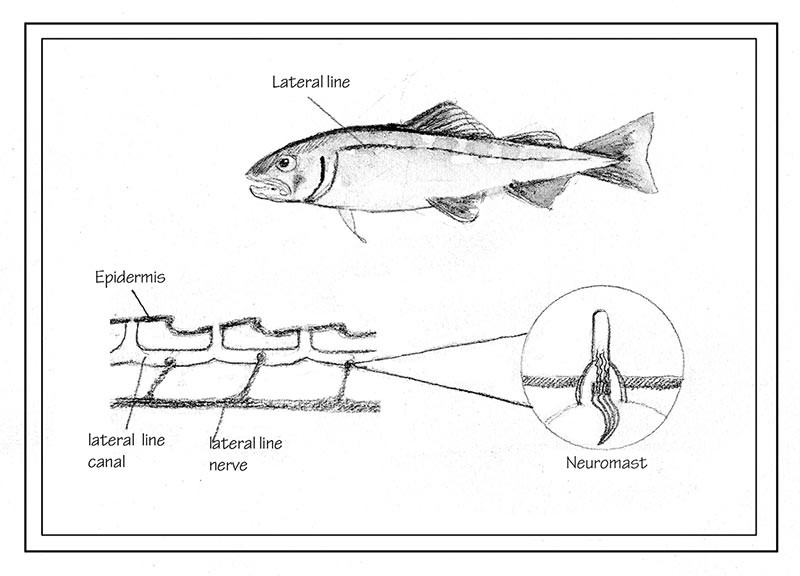
There are times when fish appear telepathic. Consider the uncanny way a school of bait fish moves as one to avoid a predator, or the way goldfish in their lighted bowl turn towards the glass when someone walks into the dark room. Researchers often describe this ability as “touch-from-a-distance.” But fishy sixth sense is closer to hearing than touch. It’s what allows salmon to deftly ply the currents and eddies as they make their spawning runs upstream. They listen to the flow.
Fish have a kind of full-body flow antenna that is a network of microscopic hair cells, much like the hair cells of our inner ear. These detect minute changes in water velocity and direction. Clumps of these cells are called neuromasts, and some of them are on the surface of the fish between the scales. Others are embedded inside canal systems. The entire hydrodynamic antenna is referred to as the lateral line.
Jimmy Liao, a neuroscientist and researcher in biomechanics at the University of Florida, was particularly interested in learning more about the distribution of neuromasts on the fish’s head. “The remarkable thing,” Liao told me, “is that all 30,000 or so known bony fish species have the same configuration of sensory canals – one goes over the eye, another under the eye and the third along the chin.”
Liao teamed up with New York University mathematician Leif Ristroph and physics professor Jun Zhang from Shanghai to map the neuromasts of one of these head canal branches and then see what happened when they subjected that configuration to flowing water. It wouldn’t work to attach heavy sensors and wires to a real fish, so they built a plastic fish molded from an actual rainbow trout and attached tiny pressure sensors to it. The plastic trout went into a water-filled flume where they could dial up water current with an electric propeller.
What they learned confirmed their hypothesis, that the greatest density of sense cells is found precisely where pressure changes are felt the greatest. “The distribution of neuromasts is not randomly evolved,” Liao told me, “but designed in an optimal way.” Fish use the sense of changing flows in precise ways to guide their movements.
Liao’s neuro-mechanical analysis of the lateral line may lead to technological innovations. For example, “engineers designing deep ocean submersibles can incorporate flow sensors to guide the craft in the dark. Our research can tell them how many flow detectors are needed and where they should be placed,” Liao said.
There may be applications for human hearing as well. Because fish neuromasts are on the surface, they’re much easier to study than the nearly identical hair cells inside a person’s inner ear. Scientists working to cure deafness, for example, need to better understand how nerve cells translate the physical movement of hair cells in the inner ear to the electric impulses lighting up various regions of the brain.
It might be that someday, using technologies learned from fish, we will hear with our skin. That may sound pretty far-fetched today, but sometimes nature is where the best designs are found.

